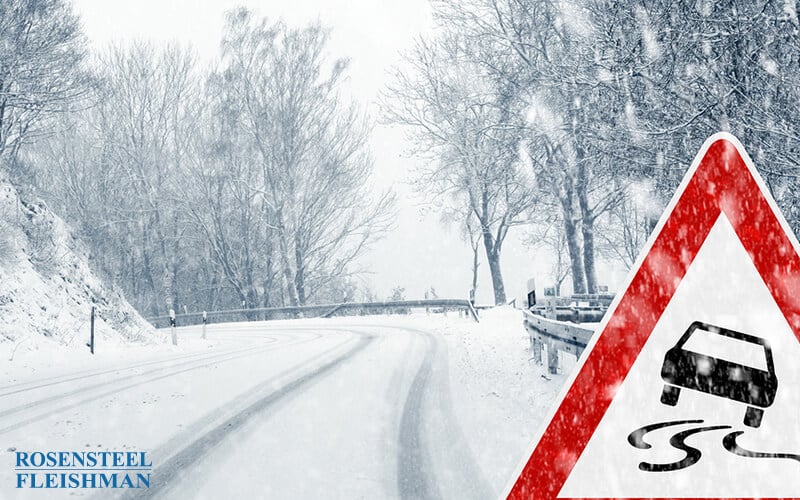Being in a car accident is stressful enough, but the situation can become even more complicated if the other driver doesn’t have insurance. It’s one of those moments where confusion and frustration collide, especially when you’re stuck with damage to your vehicle or even injuries. Many people in Charlotte find themselves in this exact situation, […]

Icy Roads and Car Accidents
It’s that time of year when winter weather can appear in our usually mild Charlotte. WSOC-TV forecasts a drop in temperatures over the course of the day, with temperatures falling below freezing overnight. With the light drizzle occurring today, along with forecasted freezing rain for early Wednesday morning, this weather might make for some difficult driving conditions. What happens if you are involved in a car accident, the cause of which is icy conditions? Who is liable for damages in this type of accident?
To collect damages in a car accident, an injured party must show that the other party was legally negligent or that the other party failed to exercise reasonable care and that such failure both actually and proximately caused the injuries sustained. A defendant in a claim for damages related to a car accident in icy conditions might argue that he is not liable under the sudden emergency doctrine. North Carolina courts have summarized the sudden emergency doctrine as follows in automobile cases:
The sudden emergency doctrine provides that one confronted with an emergency is not liable for an injury resulting from his acting as a reasonable man might act in such an emergency. Two elements must be satisfied before the sudden emergency doctrine applies: (1) an emergency situation must exist requiring immediate action to avoid injury, and (2) the emergency must not have been created by the negligence of the party seeking the protection of the doctrine.
Sobczak v. Vorholt (NC App 2007)
Sobczak involved a defendant whose car was travelling on an icy road and skidded out, which caused the car to cross the center line and hit the plaintiff’s oncoming car. It was early morning when the plaintiff and defendant were travelling and it had snowed lightly overnight. The speed limit on the road was 55 mph but the parties both estimated they were travelling at 30-35 mph because of the weather conditions. Prior to the accident, the defendant had travelled for about four miles on the road and claimed to not have observed any icy conditions, although he did see snow that had been packed down by other cars and knew that packed down snow could turn to ice. Law enforcement officers who arrived on the scene stated that they saw icy patches while travelling the same portion of the road as the defendant had.
The court of appeals first noted that the plaintiff had made out a prima facie case of negligence per se based on the defendant’s violations of the North Carolina statute which required him to drive in his travel lane unless he ascertained that it was safe to move from that lane. However, the defendant “could rebut the presumption of negligence created by a violation of section 20-146(d) by presenting evidence that he was on the wrong side of the road from a cause other than his own negligence.”
In moving on to the discussion of the sudden emergency doctrine, the court reasoned that because the defendant had observed packed down snow and knew it could turn to ice, he “was on notice of a potential encounter with ice on the road, and that hitting ice as he drove was foreseeable.” Therefore, the defendant
knew or in the exercise of reasonable care should have known that the snow on [the road] could have become ice in some areas, [and] the mere fact that he did not see the icy patch he hit in advance of hitting it is insufficient to establish that he was thereby confronted with a sudden emergency.
The court likened Sobczak to an earlier court of appeals case involving a defendant who had hyrdoplaned on a puddle of water and hit the plaintiff’s car. (Banks v. McGee 1996) The defendant in Banks argued that although she knew it was raining and water tended to puddle when it was raining, the jury should be instructed as to the sudden emergency doctrine because she did not see the puddle prior to hitting it. The court of appeals disagreed, reasoning that “[t]he question is not what she saw but instead what a reasonable person in her situation should have seen.”
The court concluded that the icy conditions encountered by the defendant was not a sudden emergency and the weather conditions should be a factor “in considering whether Defendant failed to keep a proper lookout, failed to keep his vehicle under proper control, or drove too fast for conditions.”
Based on the court’s reasoning in Sobczak that the defendant should have known that there could be icy patches on the road due to the packed down snow, it seems that if a driver were to come upon an unexpected icy patch it could entitle him to an instruction on the sudden emergency doctrine. Iowa courts have applied the following reasoning as recently as 2005:
In the present context, two main situations may exist with respect to icy highways. In one situation the icy condition is general, and the driver must be taken as being aware of it. If such a driver proceeds in normal fashion notwithstanding the ice and eventually slides on a patch of it, he cannot set up the icy condition as an “emergency.” An emergency requires “an unforeseen combination of circumstances” but the element of unforeseeability is missing. . . .
In the other situation, although the weather may be inclement, ice has not formed so far as the driver reasonably observes. He proceeds in accordance with conditions as they appear. Suddenly he encounters an unanticipated patch of ice and slides. Normally in this situation the driver may rightly claim that the decision on whether the ice was reasonably foreseeable is for the jury to make.
McCoy v. Mendenhall (Iowa Ct. App. 2005) quoting Bannon v. Pfiffner (Iowa SCt. 1983)
Of course in Iowa, winter weather and icy conditions are a much more frequent occurrence than in most parts of North Carolina, and roads are treated for winter weather more regularly, so that winter weather is less likely to result in icy spots on the road. Given the North Carolina Court of Appeals restrictive application of the sudden emergency doctrine in Sobczak in this type of situation, it is not clear that North Carolina courts would apply the doctrine in the same way as the Iowa courts have if there is winter weather.
We might also ask what effect widespread news coverage of potential icy conditions has on the “unexpected” nature of encountering an icy spot. When winter weather comes to Charlotte, it makes the news and everyone talks about it. An injured plaintiff might argue that icy spots are “foreseeable” in this regard.
If you have been injured in a car accident as a result of winter weather, visit www.rflaw.net for legal help.
Additional Car Accident Articles
Getting into a car accident can throw everything into chaos in a matter of seconds. Whether it’s a fender-bender or something more serious, the moments afterward are often filled with questions, stress, and uncertainty. You might be wondering what your next move should be, especially if the damage is more than just physical. If you're […]
Getting into a car accident can throw everything off balance. One moment you're running errands or heading home from work, and the next you're dealing with a damaged vehicle, lingering soreness, and a pile of unanswered questions. It's easy to feel overwhelmed, especially when you're unsure what to do next or who you can turn […]
Neck injuries after a car accident can be confusing, frustrating, and even scary—especially when the pain doesn't show up right away. For many people, the moments after a crash are filled with adrenaline, and it’s easy to overlook subtle signs of injury. But what happens when the pain starts hours or even days later? It's […]
